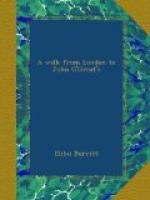After spending a few hours at Studley Park, I returned to Ripon and went on to Thirsk, where I spent the Sabbath with a Friend. The next day he drove me over to Rievaulx Abbey, which was the mother of Fountain Abbey. On the way to it we passed the ruins of another of these grand structures of that religious age, called Byland Abbey, where Robert Bruce came within an ace of capturing King Edward on his retreat from Scotland, after the Battle of Bannockburn.
One of the objects of this excursion was to visit the establishment of Lord Faversham, near Helmsley, who is one of the most scientific and successful stock-raisers, of the Shorthorn blood, in England, and to whom I had a note of introduction. But he, too, was not at home, which I much regretted, as I was desirous of seeing one of the peers of the realm who enter into this culture of animal life with so much personal interest and assiduity. His manager, however, was very affable and attentive, ready and pleased to give any information desired upon different points. He showed us a splendid set of animals. Indeed, I had never seen a herd to equal it. There were several bulls of different ages with a perfection of form truly admirable. Some of them had already drawn first prizes at different shows. Several noble specimens of this celebrated herd have been sold to stock-raisers in America, Australia and in continental countries. The most perfect of all the well-made animals on the establishment, according to my untrained perceptions of symmetry, was a milk-white cow, called “The Lady in White,” three years old. She and Mr. Fawkes’ “Lord Cobham” should be shown together. I doubt if a better mated pair could be found in England. There was a large number of cows feeding in the park which would command admiration at any exhibition of stock. Lord Faversham’s famous “Skyrocket” ended his days with much eclat. When getting into years, and into monstrous obesity, he was presented as a contribution to the Lancashire Relief Fund. Before passing into the butcher’s hands, he was exhibited in Leeds, and realised about 200 pounds as a show. Thus as a curiosity first, and as a small mountain of fat beef afterward, he proved a generous gift to the suffering operatives in the manufacturing districts.
Passing through the park gate, we entered upon a lawn esplanade looking down upon the ruins of Rievaulx Abbey. This broad terrace extended for apparently a half of a mile, and was as finely carpeted piece of ground as you will find in England. No hair of horse or dog groomed and brushed with the nicest care, and soft and shining with the healthiest vitality, could surpass in delicacy and life of surface the grass coverlet of this long terrace, from which you looked down upon that grand monument of twelfth-century architecture half veiled among the trees of the glen. This was one of the oldest abbeys in the north of England, and the mother of several of them. Some




